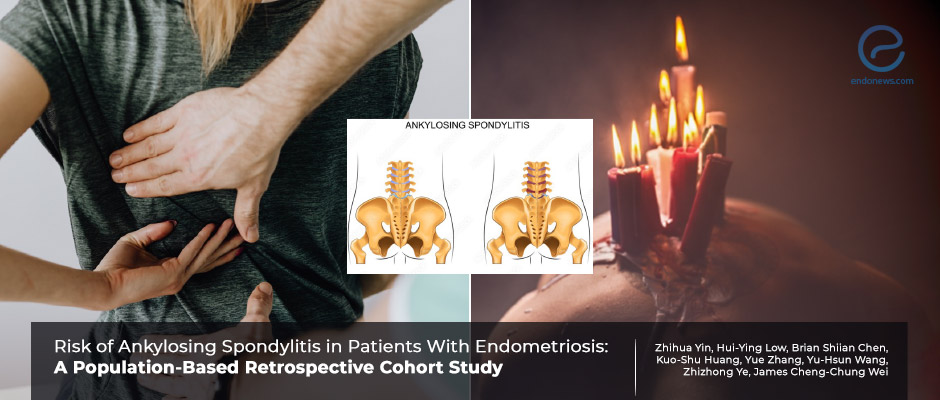Ankylosing Spondylitis and Endometriosis
Jul 14, 2022
Ankylosing spondylitis is more commonly encountered in women with endometriosis than in those without the disease.
Key Points
Highlights:
- Ankylosing spondylitis is one of the immunological diseases that can coexist with endometriosis due to sharing the same immunologic characteristics.
Importance:
- Women having endometriosis should be carefully evaluated for other autoimmune diseases such as ankylosing spondylitis, rheumatoid arthritis, systemic lupus erythematosus, Sjögren’s syndrome, and multiple sclerosis.
What’s done here?
- This retrospective cohort study was conducted to investigate the possible coexistence of endometriosis and ankylosing spondylitis.
- Age-matched women who had never been diagnosed with endometriosis were included in the control group.
- The primary outcome of the study was the incidence of ankylosing spondylitis.
- Corticosteroids and non-steroidal anti-inflammatory drugs (NSAIDs) were prescribed for at least 30 days within the first year.
Key results:
- A total of 13,145 patients with endometriosis and 78,870 women in the control group were included.
- Comorbidities such as hypertension, hyperlipidemia, chronic liver disease, major depressive disorder, chronic obstructive pulmonary diseases (COPD), diabetes mellitus, coronary artery disease, cerebrovascular disease, and cancer, except for chronic kidney disease were found to be more likely in endometriosis group.
- Corticosteroids and NSAIDs were more frequently used in the endometriosis group as significant.
- Ankylosing spondylitis was more commonly diagnosed in endometriosis patients than in those non-endometriosis subjects as the cumulative incidence.
- Women with major depressive disorder and COPD were detected to have ankylosing spondylitis more frequently.
- Corticosteroid application was associated with a lower risk of ankylosing spondylitis whereas NSAIDs use showed an increased risk of AS but not significantly.
- The association between endometriosis and ankylosing spondylitis was more prominent at ages 40–49 compared with ages 30–39.
Strengths and Limitations:
- This is the first study evaluating the relationship between endometriosis and ankylosing spondylitis with the use of the nationwide population-based database.
- A large sample size, minimum selection bias, and enough follow-up time are other strengths of the study.
- The absence of severity and multifactorial aspect of endometriosis and laboratory data such as hormone levels and inflammatory markers could be accepted as the limitation of the study.
Lay Summary
There are several theories contributing the development of endometriosis: one of the proposed pathophysiological mechanisms is the abnormality in immune and inflammatory system. Several immunologic diseases coexist with endometriosis depending on the common immunologic characteristics such as Tumor necrosis Factor (TNF) and the helper T cell (Th17) pathway.
Yin et al., from Taiwan, published a retrospective cohort study titled “Risk of Ankylosing Spondylitis in Patients With Endometriosis: A Population-Based Retrospective Cohort Study” in the journal named Frontiers in Immunology. The authorssought to assess the coexistence of endometriosis and ankylosing spondylitis.
They investigated the cumulative incidence of ankylosing spondylitis in women with endometriosis compared with non-endometriosis group. Comorbidities were found to be more likely in endometriosis group. Ankylosing spondylitis was more commonly diagnosed in endometriosis patients than in those of non-endometriosis subjects as the cumulative incidence. Corticosteroid application was associated with a lower risk of ankylosing spondylitis whereas non-steroid antiinflammatory use showed an increased risk of Aankylosing spondilitis but not significantly. Additionally, the association of endometriosis and ankylosing spondylitis was more prominent at ages 40–49 compared with ages 30–39.
“Clinicians should pay attention to the risk of AS in patients with endometriosis and possible underlying endometriosis in managing AS patients.” the authors added.
Research Source: https://pubmed.ncbi.nlm.nih.gov/35784295/
ankylosing spondylitis autoimmune diseases endometriosis immunology

